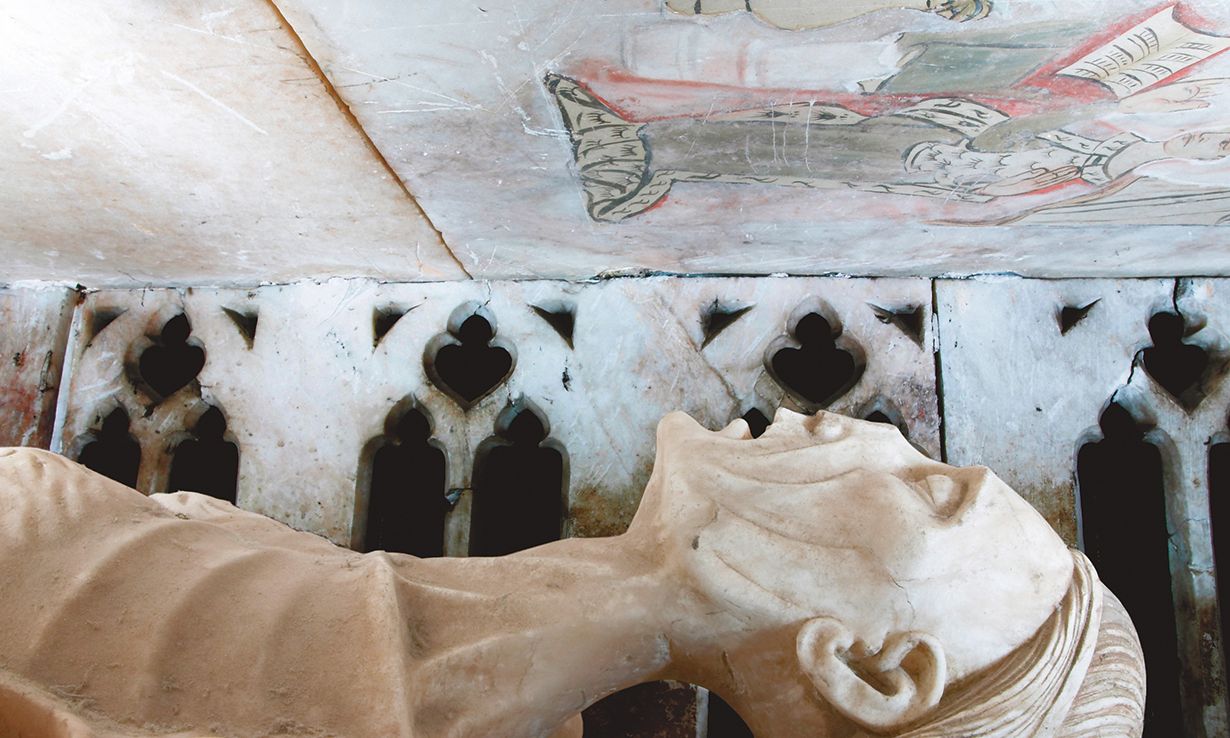Newham’s photo of the shrivelled nude effigy of Alice de la Pole, the Duchess of Suffolk—and Chaucer’s granddaughter—offers a rare view of a late Medieval “double-decker” tomb C.B. Newham
Australian by birth, C.B. Newham works in IT. His other life is spent compiling The Parish Church Photographic Survey, a digital record of the estimated 10,000 rural parish churches in England. (Towns do not count.) Now almost complete, this bold project picks up the baton once carried by the now defunct Royal Commission on the Historical Monuments of England in making a record of the country’s greatest tangible inheritance. His privately funded project has yielded great riches, and the sepulchral stars are gathered together in this handsome and hefty landmark book.
Newham is a superb photographer. His precise eye and mastery of digital techniques make for some remarkable pictures. A specialism is the overhead shot, an elaborate process requiring sophisticated image rectification; this is seen to telling effect over and over again, as effigies are depicted from above in a manner only angels and spiders could achieve.
Newham is keen on “double-decker” late medieval tombs that show the elegant effigy above and the wizened cadaver below. Anyone who has visited St Mary’s, Ewelme in Oxfordshire to see the renowned tomb of Alice de la Pole, Duchess of Suffolk (who died in 1475), granddaughter of Geoffrey Chaucer, will know that her shrivelled nude effigy is confined in a low chamber beneath the tomb chest, and very hard to see—yet Newham has somehow produced a full-length portrait of this gaunt grimness.
Most effigies are hard to take in when seen in the flesh. By taking the viewer above, Newham enables these sculptures to be studied as compositions imbued with their own movement, poise and personality. Richard de Pembridge’s armoured figure at All Saints Clehonger (Herefordshire, died 1345/46) shows a restless figure clutching a dagger as he glances suspiciously sideways, trampling a dog.
Newham’s selection repeatedly shows how rich a source of information church monuments can be into the lives and characters of the tomb-raising classes. Examples are selected from all epochs, and browsing these pages is the finest possible way to see the various shifts in sepulchral style. Newham has a very good eye for Neoclassical marble, and gives more modern sculptors like Joseph Edgar Boehm (1834-1890) and Feodora Gleichen (1861-1922) due coverage too.
These images look very well in this beautifully designed book: they deserve to be shown in exhibition format on a large scale too. Photographing in churches requires patience: patience to get inside, patience in moving aside the detritus of parish life, patience in getting the right light. It also needs an eye for composition, as monuments are often hemmed in. Newham follows in the tradition of Edwin Smith in capturing the atmosphere of tombs as well as their details.
The illustrations are the stars of the show but there is more to this work than photographs alone. It is organised geographically, by region: numbered maps and an index show where the selected tombs are. Treasure-house churches like Arundel, Bottesford and Blickling yield three selections apiece: so does the more remote Devon church of Tawstock, the dynastic mausoleum of the Earls of Bath.
Each tomb has a brief essay of a couple of hundred words, which gives a biographical outline of the subject(s) and a description of the tomb. These are readable and to the point, though unreferenced (nor is there a bibliography in the book, though one can go onto the author’s website to find one). There is a glossary at the end, and a very useful section containing biographies of more than 100 sculptors responsible for the selected monuments, which range from the 16th-century alabasterer John Gildon, to Rory Young (born 1954), whose delightful memorial to the Rev. Henry Cheales (died 1984) at Wyck Rissington, Gloucestershire, features a maze. One minor beef is that the captions accompanying the plates do not include dates or sculptors.
This is the loveliest book ever produced on church monuments by a long way, and much more than a picture book. It is hard to imagine a better introduction to this often-overlooked area of infinite interest, charm, curiosity and sorrow.
• Country Church Monuments, C.B. Newham, Particular Books, 728pp, more than 400 colour and b/w illustrations, £40 (hb), published 6 October 2022
• Roger Bowdler is a partner at Montagu Evans, advising owners on historic buildings. He was the director of listing at Historic England and writes on funerary art

